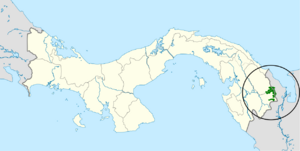Tacarcuna wood quail facts for kids
Quick facts for kids Tacarcuna wood quail |
|
|---|---|
| Conservation status | |
| Scientific classification | |
| Genus: |
Odontophorus (bird)
|
| Species: |
dialeucos
|
 |
|
The Tacarcuna wood quail (Odontophorus dialeucos) is a special kind of bird. It belongs to the family of Odontophoridae, which are also called New World quails. You can find this bird living in the forests of Colombia and Panama.
Contents
About Its Family
Scientists group living things into families. This helps us understand how they are related. Some experts have thought that the Tacarcuna wood quail might be the same species as a few other wood quails. These include the gorgeted wood quail, Venezuelan wood quail, black-fronted wood quail, and black-breasted wood quail. However, most bird experts do not agree with this idea. The Tacarcuna wood quail is currently seen as its own unique species.
What It Looks Like
The Tacarcuna wood quail is about 22 to 28 centimeters (9 to 11 inches) long. That's about the size of a small ruler. Male quails weigh around 264 grams (9.3 ounces). Females are a little lighter, weighing about 258 grams (9.1 ounces).
Male quails have a black head and throat. They have a white stripe above their eyes and on their chin. The sides and back of their neck are a warm cinnamon color. Their back and rump are olive brown with small black wavy lines. Their chest and belly are chestnut brown with white speckles.
Female quails look similar to males. However, their underparts are more of a yellowish-brown color. Young quails look a lot like the females. But their white chin patch is smaller, and the black on their throat is wider.
Where It Lives
The Tacarcuna wood quail lives in a specific area. You can find it along the Tacarcuna Ridge. This ridge is located in Panama's Darién Province and Colombia's Chocó Department.
These birds prefer to live on the forest floor. They like subtropical forests, which are warm and humid. They are usually found at high places, between 1,050 and 1,450 meters (3,440 to 4,760 feet) above sea level.
How It Behaves
What It Eats
Scientists do not have much information about what the Tacarcuna wood quail eats. We also don't know how it finds its food. More research is needed to learn about its diet and foraging habits.
Life Cycle
We know very little about how the Tacarcuna wood quail reproduces. One young quail was found in early June. This suggests that they might lay eggs and have chicks around that time. However, there is no other published information about their breeding habits.
Its Calls
The sounds and calls of the Tacarcuna wood quail are not well known. Scientists are still trying to learn more about the different noises these birds make.
Its Conservation Status
The IUCN (International Union for Conservation of Nature) keeps track of how endangered animals are. They first listed the Tacarcuna wood quail as "Near Threatened." This means it was close to being in danger. But since the year 2000, its status has changed to "Vulnerable."
Being "Vulnerable" means the bird faces a high risk of becoming extinct in the wild. The Tacarcuna wood quail lives in a very small area. This makes it easily affected by random events like bad weather. It is also sensitive to things that people do, such as cutting down forests. Protecting its habitat is very important for its survival.


